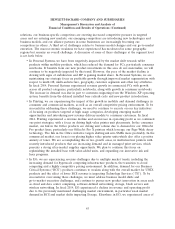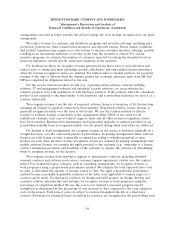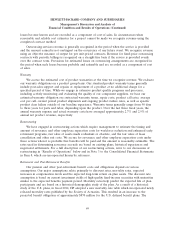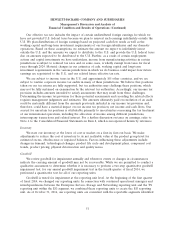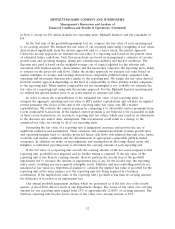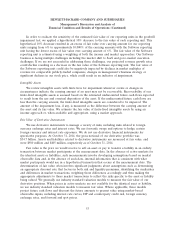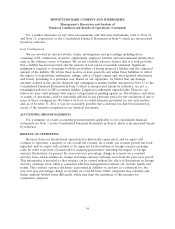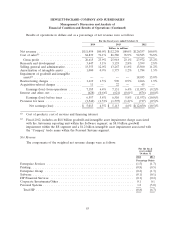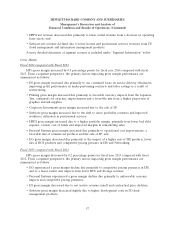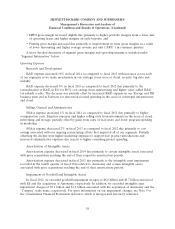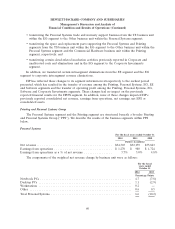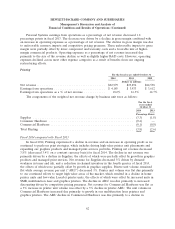HP 2014 Annual Report Download - page 61
Download and view the complete annual report
Please find page 61 of the 2014 HP annual report below. You can navigate through the pages in the report by either clicking on the pages listed below, or by using the keyword search tool below to find specific information within the annual report.HEWLETT-PACKARD COMPANY AND SUBSIDIARIES
Management’s Discussion and Analysis of
Financial Condition and Results of Operations (Continued)
In order to evaluate the sensitivity of the estimated fair value of our reporting units in the goodwill
impairment test, we applied a hypothetical 10% decrease to the fair value of each reporting unit. This
hypothetical 10% decrease resulted in an excess of fair value over carrying amount for our reporting
units ranging from 6% to approximately 10,000% of the carrying amounts with the Software reporting
unit having the lowest excess of fair value over carrying amount of 6%. The fair value of the Software
reporting unit is estimated using a weighting of both the income and market approaches. Our Software
business is facing multiple challenges including the market shift to SaaS and go-to-market execution
challenges. If we are not successful in addressing these challenges, our projected revenue growth rates
could decline resulting in a decrease in the fair value of the Software reporting unit. The fair value of
the Software reporting unit could also be negatively impacted by declines in market multiples of
revenue for comparable publicly-traded companies, changes in management’s business strategy or
significant declines in our stock price, which could result in an indicator of impairment.
Intangible Assets
We review intangible assets with finite lives for impairment whenever events or changes in
circumstances indicate the carrying amount of an asset may not be recoverable. Recoverability of our
finite-lived intangible assets is assessed based on the estimated undiscounted future cash flows expected
to result from the use and eventual disposition of the asset. If the undiscounted future cash flows are
less than the carrying amount, the finite-lived intangible assets are considered to be impaired. The
amount of the impairment loss, if any, is measured as the difference between the carrying amount of
the asset and its fair value. We estimate the fair value of finite-lived intangible assets by using an
income approach or, when available and appropriate, using a market approach.
Fair Value of Derivative Instruments
We use derivative instruments to manage a variety of risks, including risks related to foreign
currency exchange rates and interest rates. We use forwards, swaps and options to hedge certain
foreign currency and interest rate exposures. We do not use derivative financial instruments for
speculative purposes. At October 31, 2014, the gross notional of our derivative portfolio was
$54.7 billion. Assets and liabilities related to derivative instruments are measured at fair value, and
were $980 million and $405 million, respectively as of October 31, 2014.
Fair value is the price we would receive to sell an asset or pay to transfer a liability in an orderly
transaction between market participants at the measurement date. In the absence of active markets for
the identical assets or liabilities, such measurements involve developing assumptions based on market
observable data and, in the absence of such data, internal information that is consistent with what
market participants would use in a hypothetical transaction that occurs at the measurement date. The
determination of fair value often involves significant judgments about assumptions such as determining
an appropriate discount rate that factors in both risk and liquidity premiums, identifying the similarities
and differences in market transactions, weighting those differences accordingly and then making the
appropriate adjustments to those market transactions to reflect the risks specific to the asset or liability
being valued. We generally use industry standard valuation models to measure the fair value of our
derivative positions. When prices in active markets are not available for the identical asset or liability,
we use industry standard valuation models to measure fair value. Where applicable, these models
project future cash flows and discount the future amounts to present value using market-based
observable inputs, including interest rate curves, HP and counterparty credit risk, foreign currency
exchange rates, and forward and spot prices.
53




